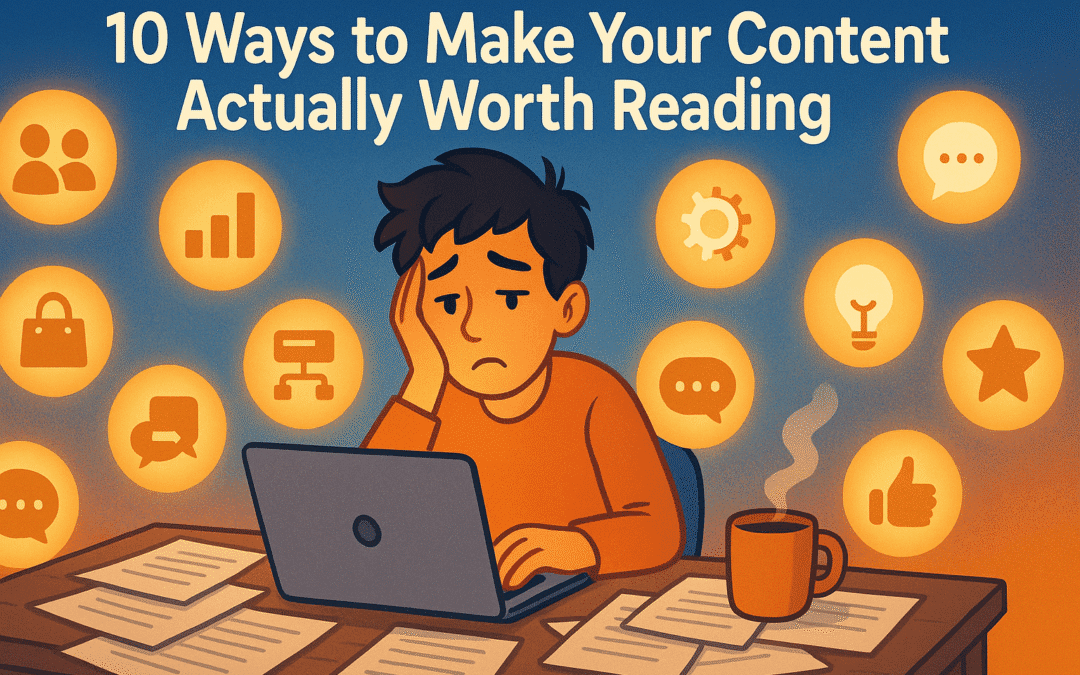If you want to make content that’s actually worth reading, you’ve got to stop cranking out the same cookie-cutter junk everyone else is posting. Nobody’s sitting around thinking, “Wow, I can’t wait to read another ‘Top 10 Tips for SEO’ article.” Nope. People want stuff that feels real, sounds human, and maybe even makes them laugh while they learn something. The secret? It’s all about picking the right lens, ten of them, to be exact, that help you tell your story from the angle that fits best. Whether you’re sharing a personal tale, breaking down the basics, or flexing your data muscles, there’s a lens that’ll make your content pop instead of flop.
1. People
Everybody loves a good story. Talk about real folks, like the guy who’s been fixing HVAC systems since the ‘80s or the nurse who’s seen it all. People connect with people, not with buzzwords. You can have all the stats in the world, but if you drop in one story about a single mom running her own trucking company, boom… now you’ve got their attention!
If you want to see a real-world breakdown of how personal storytelling works in marketing, check out my piece on Local Agency Marketing Strategy: Stop Chasing Every City and Start Owning Your County.
2. Basics
This is your “Content 101” stuff. Perfect for beginners who just Googled “What is SEO?” five minutes ago. Keep it simple, keep it short, and for the love of coffee, skip the jargon. Pretend you’re explaining it to your uncle at Thanksgiving who still calls every app “The Facebook.”
Need a simple SEO refresher? You can start with SEO for Small Businesses: A Practical Guide… it’s plain English, no jargon, and built for beginners.
3. Details
Now this is for the nerds among us, and I mean that in a loving way. It’s the deep-dive stuff. Long, meaty articles that get into the nitty-gritty. You’ll lose some folks along the way, sure, but the ones who stick around will actually trust you know what you’re talking about.
If you’re ready to get technical, dive into Step-by-Step: How To Implement Entity SEO or Two Ways To Think About Entity SEO. They’re the “deep end of the pool” kind of reads.
4. History
People underestimate this one, but trust me… throw in a little backstory and suddenly you sound like a genius. Whether it’s “How TikTok Took Over the World” or “The Rise and Fall of the Fax Machine,” everyone loves a little trip down memory lane. Just try not to sound like a history textbook; nobody wants flashbacks to sophomore year.
Want a fun blast from the past? My article on Google’s HEART Framework (For People Who Don’t Speak Silicon Valley) breaks down where a lot of modern UX ideas actually came from.
5. Process
These are your how-to guides. You’re basically saying, “Here’s how to do the thing without messing it up.” Recipes, DIYs, tutorials, this stuff kills on YouTube for a reason. Just make sure the steps actually work; nothing makes people angrier than following your guide and ending up with a smoking blender.
If you like step-by-step stuff, I’ve got How to Clean Up Your Portfolio Categories Before Google Thinks You’re a Mess and Local Keyword Research and Content Creation that walk you through processes that actually work.
6. Curation
This one’s for the collectors. You don’t have to make something new… you just gather the best stuff that’s already out there. “Top 5 marketing podcasts,” “Best grill recipes,” “The ultimate playlist for coding at 2 a.m.” Easy to make, fun to read, and everyone loves a good list.
For a collection of cool, data-driven resources, peek at EmbeddingGemma Unpacked: 10 Essential Questions Answered… it’s basically a “Top 10” of AI insights.
7. Data
Ah yes, the numbers game. You tell a story with stats. Maybe you’re saying 80% of people skip ads (shocker), or that the average person spends six hours a day on their phone (probably true, sadly). Data gives your point some muscle. Just don’t drown people in spreadsheets… they came to learn something, not do calculus.
If you’re into the numbers, AARRR Metrics and Query Fan-Out: How Google AI Deep Search Works both dig into data stories that’ll make you sound way smarter at meetings.
8. Product
This is where you talk shop. You’re showing off your product, but try to make it sound less like a sales pitch and more like, “Hey, this thing’s pretty cool and here’s why.” Do demos, setup tips, behind-the-scenes stuff, anything that makes folks think, “Huh, maybe I need that.”
And if you’re curious how to write about products without sounding like a pushy salesperson, give The Complete Guide to Local SEO Services: Problems, Solutions, and the Language That Sells a read.
9. Example
Sometimes an idea is too big… like “innovation” or “diversity.” Hard to wrap your head around that kind of stuff. So, you zoom in. Pick one small story that shows the big picture. Like how one company’s weird experiment with a four-day work week changed everything. It’s the “show, don’t tell” approach.
Need to see how one small example explains a big idea? Check out Analysis Paralysis in Digital Marketing (When Thinking Too Much Costs You Money)—it’s a single concept that says a lot.
10. Opinion
And finally, the spicy one. Your take. People love, or love to hate, a good opinion piece. Tell folks what you really think about something. Maybe it’s why remote work isn’t all it’s cracked up to be or why content marketing should be required in college. Just be ready for the comment section.
So yeah, those are your ten lenses. Pick one, mix a few, whatever fits your vibe. Whether you’re teaching, ranting, or just sharing cool stuff, there’s a lens for it. Now grab a drink and start typing, your audience isn’t going to entertain itself.
And if you like a little personal flavor, Why I Release Control to Build Real Capacity and Understanding Karma and Self-Determination are full of my unfiltered takes.
Casey’s Closing Thoughts
At the end of the day, making content that’s worth reading isn’t rocket science… it’s about knowing your angle and talking to people like, well, people. You don’t need fancy words or viral gimmicks; you just need to pick the right lens and tell a story that actually connects. Whether it’s a quick how-to, a personal story, or a bold opinion, the goal’s the same: make folks stop scrolling and start paying attention. Keep it honest, keep it human, and your content won’t just get clicks, it’ll actually get remembered.

